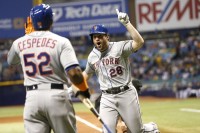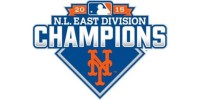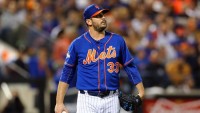Asdrubal Cabrera
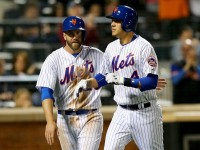
Going into the 2016 season, there was only thing missing from the roster – a backup first baseman.
However, fans were told to rest assured because there was a solution on their roster. The Mets were going to teach the position to Wilmer Flores. They were going to give a first baseman’s glove to their two catchers, Travis d’Arnaud and Kevin Plawecki. This would not only allow the team to have additional options at first, but it would also allow them to find more at bats for their two young catchers over the course of a season. Opening Day is a little over a week away. Guess how many combined games these three players have played at first base this Spring?
One.
Just one. Flores finally played a game there, and he described the experience as “weird.” He was only there because Lucas Duda couldn’t play yesterday. It’s probable Flores will get one other game there. The chances the catchers will get a game there now are slim to none. It’s just one giant wasted opportunity.
Sure, the Mets had Flores workout with Keith Hernandez at first base this Spring. In that sense, the Mets didn’t waste the time they had this Spring. However, there is just no substitute for game experience. Worst yet, they just wasted opportunities to get Flores game action at first. Marc Krauss, who shouldn’t play one game with the 2016 Mets, has played 15 games this Spring.
With so much on Flores’ plate this Spring, this was bound to happen. He had to prepare to become the main backup at each and every infield position. He had to work to become a better, more patient hitter at the plate. With David Wright‘s back, he has to be as ready as possible to play third. With Asdrubal Cabrera‘s injury coupled with Ruben Tejada‘s release, Flores had to spend time being sure he was ready to play shortstop. First base just fell by the wayside.
This all means one of three things:
- Duda is going to play 162 games;
- The Mets are comfortable with Flores at first regardless of his lack of game time there; or
- Eric Campbell is going to make the Opening Day roster.
Each passing day, it appears more and more likely that Campbell will be on the Opening Day roster. He’s played 17 games this Spring. Unlike Flores, he has played multiple games at first. Despite fans’ opinion of him, the Mets organization is bullish on Campbell’s abilities as a versatile bench player.
So, it’s most likely that the Mets have always seen Campbell as the backup first baseman. It would be the most plausible explanation why the Mets failed to expose Flores to first base for the vast majority of Spring Training. Conversely, if Campbell isn’t going to make the roster, the Mets have wasted Spring Training with respect to their inability to give Flores game action at first.
The most likely result is Eric Campbell making the Opening Day roster.
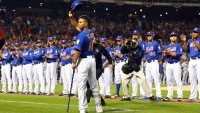
I’m sure Jedd Gyorko could be the answer to many questions. However, I’m fairly positive he’s not the answer to the question, “Who should be your starting shortstop?”
With the injury to Jhonny Peralta, Gyorko is the Cardinals starting shortstop. Unless the Cardinals make a move, Gyorko will be the shortstop for the next two to three months. Now, Gyorko was never anything more than an average second baseman which a career -1.5 UZR over his three year career. That doesn’t bode well for his chances to be a good to adequate shortstop. Like most, I’m assuming if any team can make it work, it’s the Cardinals.
With that said, it’s a good time for the Mets to call the Cardinals. From all the reports this Spring, it appears that the Mets might be looking to move on from Ruben Tejada. It’s probably the right move too.
Last year, Tejada had an impressive finish to the season. Although never mentioned as such, he was part of the reason why the Mets rallied to win the NL East. His gruesome injury in the NLDS was a rallying cry for the Mets and Mets fans throughout the postseason. However, he’s on the last year of his deal, and he’s an expensive backup eating up a spot on the 40 man roster.
The Mets right now have absurd depth at the shortstop position. Asdrubal Cabrera is penciled in as the starter the next two years. Wilmer Flores grew into the role and handled the position very well when pressed into shortstop duty again in the postseason. Former second round pick Matt Reynolds is competing for a utility role in the majors. On top of that, the Mets have two big shortstop prospects in Gavin Cecchini and Amed Rosario. Long story short, the Mets don’t need shortstop depth.
What they do need is 40 man roster space. So far, Jim Henderson is having a nice Spring and may be on the inside track to locking down a spot on the Opening Day bullpen. The Mets are talking about letting Kevin Plawecki start the year in AAA. This means, as of right now, Johnny Monell would open the year as the backup catcher. There’s a problem with Henderson and Monell making the Opening Day roster.
Neither player is on the 40 man roster, and the Mets have no spots open. Even if the Mets placed Zack Wheeler on the 60 day DL, the Mets would still need to drop someone else from the 40 man roster to add both Henderson and Monell. This could be accomplished by trading Tejada.
It seemed like Tejada turned a corner last year. Unfortunately, with one dirty play he is back on the bench, and frankly, occupying a roster spot the Mets need. It may not seem fair. It may seem cruel, but it’s time for the Mets too move on from Tejada. They should do it now with the Cardinals having a need, and the Mets wanting to maximize the return they would receive for Tejada.
Editor’s Note: this article also appeared on metsmerizedonline.com
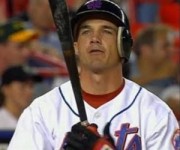
Whenever a prospect is coming through the system or a young player makes his way to the majors, invariably there is a comparison made to an All Star caliber player. Very rarely do we see a comparison to a utility player or a grinder like Joe McEwing.
With that said, if Matt Reynolds wants to be a part of this Mets team going forward, he will need to become this generation’s Super Joe.
Right now, Reynolds path to the majors is blocked. At the major league level, the Mets have Asdrubal Cabrera, Ruben Tejada, and Wilmer Flores provide extraordinary major league depth at the shortstop position. On the horizon, the Mets have two very well regarded shortstop prospects in Gavin Cecchini and Amed Rosario. For what it’s worth, Rosario is likely ticketed to play shortstop in AA, and Cecchini will be the shortstop in AAA. In short (pun intended), Reynolds will never be the shortstop for the Mets.
Even if he moves off of shortstop, his options are limited. He’s blocked at second by Dilson Herrera. Even if the younger Herrera were to falter, it’s much more likely that the Mets would turn to Cecchini or sign a free agent than Reynolds. Also, given his lack of power throughout the minors, it’s unlikely the Mets will turn to him go play third. No, Reynolds’ future, at least with the Mets, is as a utility player.
For his part, Reynolds is willing to play all over the field just to make it to the majors. He will play some outfield during Spring Training. As Reynolds told Adam Rubin, he knows a position change is in order:
No one has talked to me about it, but I heard about it from press conferences and everything. I’m willing to do whatever it takes to make it to the big leagues. I figured that I’d probably be changing positions. Honestly, I just look at it as it makes me more versatile, and there’s more opportunity for me to get called up and maybe stay up there.
Now, Joe McEwing was only a 28th round pick. When you are a 28th round pick, you are not seen as a prospect. You have to be ready, willing, and able to do whatever is necessary to get to the majors. It’s not only a talent issue. It’s a mindset. You have to show a lot of character and resiliency not only to make it to the majors, but also to stay there.
It was McEwing’s attitude and drive that helped him have a nine year career. It’s why Tony LaRussa requested a pair of autographed spikes from McEwing. He has the type of energy and drive that is infectious. It’s why he was a useful player. It’s why teams loved having him on the roster. It’s why he stays in the game as a major league coach and is a potential manager.
Reynolds was a second round pick. Typically, second round picks are not seen as utility players. As long as they produce, they usually have an easier path to the majors. With that said, it’s no guarantee. At some point, every player faces a turning point in their careers. For Matt Reynolds, that time is now. It’s time for him to embrace his future as a utility player.
Seemingly, he’s doing that. If he meets this challenge with the same drive and enthusiasm that McEwing once did, Reynolds has a real future not just with the Mets, but in baseball. It’s quite possible Reynolds’ future with the Mets is this generation’s Joe McEwing. Right now, Reynolds seems ready to do what is necessary to get to that point.
If he does, that means Reynolds will have a fine major league career.

While the Mets are certainly favorites in the NL East, they are not unbeatable. Any team is subject to the injury bug. This team projects to be a high strikeout team. There was the bizarre claim that the position players are too old. However, I did not think that people would cite middle infield defense as a cause. No, seriously.
In an offseason where the Mets jettisoned Daniel Murphy and moved Wilmer Flores to the bench, the narrative has been that the Mets are much improved defensively over last year. It appears not everyone is buying it, so let’s analyze to see if it’s true.
UZR
Generally speaking, Ultimate Zone Ratibg (UZR) measures a fielder’s range. Obviously, the better the number, the better the range. The better the range, the more opportunities to make plays.
In measuring year to year UZR, you may get a sense of how that player performed that season. However, it is too small a sample size to determine the player’s defensive abilities. You need a minimum of three years to do that. As such, to determine if the Mets are better defensively as per UZR, the 2015 UZR, along with the prior two years, should be reviewed.
Here are Murphy’s UZRs for over the past three years:
- 2015 – (1.3)
- 2014 – (5.6)
- 2013 – (4.9)
All told, the combined -11.5 suggests what many already assumed. Murphy is a poor defensive second baseman. In 2016, he’s being replaced by Neil Walker, whose UZR over the past three seasons are as follows:
- 2015 – (6.8)
- 2014 – (6.8)
- 2013 – (1.4)
Walker has a -15 UZR. He’s coming off consecutive -6.8 UZR seasons. At least in terms of UZR, he was worse than Murphy last year, and he’s been worse than Murphy over the part three years. In terms of UZR, the Mets have taken a step back defensively at second.
The Mets sought to upgrade the shortstop position by bringing in Asdrubal Cabrera, who most fans perceived as an upgrade offensively and defensively. Here is Cabrera’s UZR at shortstop over the past three seasons:
- 2015 – (6.0)
- 2014 – (6.6)
- 2013 – (12.8)
Wow. That’s a -25.4. To see if that’s an upgrade, here are Flores’ UZR at shortstop:
- 2015 – (2.5)
- 2014 – 4.0
Now, before we point to Flores’ having a 2.5 UZR over two years, it’s important to note, it’s only two years of data. Furthermore, in each of those two years, Flores was not the everyday shortstop for a full season. Also, your eyes will tell you that he struggled there, especially early in the season. With that said, when thrust into the position in the postseason with no safety net, he played well at shortstop. While the team had defensive miscues in the World Series, Flores was not one of those players.
Also, keep in mind that Cabrera was that poor of a defensive shortstop. Therefore, as far as UZR is concerned, the Mets are actually worse defensively.
DRS
Generally speaking, Defensive Runs Saved (DRS) measures a player’s ability to make plays at their position as opposed to an average player at their position. Like UZR, the higher the number the better. Furthermore, like UZR, DRS is best viewed in three year clips to get a true measure of a player’s ability.
Here is the DRS for Daniel Murphy over the past three years:
- 2015 – (6)
- 2014 – (10)
- 2013 – (13)
Looking over these numbers, Murphy has a cumulative -29 DRS over the past three years. While it can be argued that he’s been improving, it doesn’t change the fact that he’s still a poor defensive second baseman. Conversely, here are Neil Walker’s numbers:
- 2015 – (2)
- 2014 – (2)
- 2013 – 9
In reviewing Walker’s numbers, he may have slipped a little the past two years; however, he’s still a positive 5 in DRS. In reviewing DRS, Walker is a much better defender at second base than Murphy has been.
Neil Walker’s new double play partner, Asrubal Cabrera, has not had DRS numbers as strong as Walker:
- 2015 – (7)
- 2014 – (7)
- 2013 – (16)
Again, Cabrera has ugly numbers. Over the past three years, he sits at a -30 DRS. For someone that is supposed to be an upgrade, these are not promising numbers. However, in order to determine if he’s actually an improvement, we need to look at Flores’ numbers:
- 2015: (10)
- 2014: (3)
Again, the caution with Flores is that these stats are a small sample size. He still hasn’t played a full season at the position. With that said, if you wanted a stat to confirm the your eye test, this stat is the one. However, before casting dispersions on Flores, keep in mind the Mets are replacing him with a bad shortstop with limited range.
Conclusion
Using UZR and DRS, there is a reasonable debate to be had as to whether Murphy or Walker is better at second base. However, when framing those arguments, it should be noted Walker has been in decline the past few years. So yes, Walker MIGHT be better, but it’s also true he’s getting worse at the position.
As for shortstop, the only thing we truly know is that Cabrera is bad defensively. He’s 30 years old and not likely to get any better. He’s replacing a 24 year old that seemingly grew into the position. Flores played very well defensively in the postseason.
Overall, while Mets fans may believe the team is better off defensively without Murphy and Flores up the middle, the stats don’t bear that out. Rather, the Mets are more likely to have the same deficiencies they had last year.
If you are going to argue the current Mets double play combination is better, it is not because of their defense.

After the Mets make a decision at catcher, the team appears like they will have between $82 – $96 million to build a roster and re-sign their pitching.
Looking at the roster, the Mets will need to obtain starters at the following positions: 1B, 2B, SS, and RF. David Wright is scheduled to make $15 million, so whether or not you believe he will be able to stay at the position, he will remain with the team in some capacity. Michael Conforto should still be with the team as the leftfielder. Finally, unless the Mets can move him, Juan Lagares and his $9 million salary will be the team’s centerfielder. The Mets organization is fairly well stocked with position players right now, and they might be able to fill out the roster with cheap, cost-controlled talent.
First Base
Somewhat controversely, Keith Law named Dominic Smith the 29th best prospect in all of baseball. He’s the first baseman of the future.
Accordingly to the scouting reports, Smith is a good defensive first baseman that should be able to hit. The debate really is whether he will hit for power. Whether or not he hits for power, people see him as being able to field the position and be a good major league hitter.
With Lucas Duda being a free agent in 2018, the Mets will need Smith to be ready. If he’s not ready, the Mets will need a stopgap. In either event, by the time the Mets pitchers start to become free agents, Smith should be the first baseman earning around $500,000.
Second Base
We have to assume that one of these years Dilson Herrera is going to transition from second baseman of the future to the Mets second baseman. With Neil Walker only having one year until free agency, it appears that time will be 2017.
Right now, Herrera has less than one year’s service time. For all the supposed newfound depth, it’ll probably be Matt Reynolds getting called up to the Mets. That will preserve his service time. It means that in 2019, Herrera should be the second baseman, and he will have accrued two full years service time. Unless he gets enough playing time, it appears like he will avoid Super Two status meaning he will be in the same $500 – $600 thousand range as Smith.
Shortstop
As far as organizational depth, the Mets seemingly have an embarassment of riches with two high end shortstop prospects with Gavin Cecchini and Amed Rosario. They also have the aforementioned Reynolds.
Given Asdrubal Cabrera‘s contract, Cecchini and Rosario are going to have time to develop on the minors. At a minimum, Cabrera is signed to be the Mets shortstop through the 2017 season. If he produces well, or the prospects need another year, Cabrera has an option that could keep him with the Mets through the 2018 season.
As such, neither Cecchini or Rosario will be arbitration eligible at the time the Mets pitchers start to reach free agency. Accordingly, the Mets will only have to spend around $500 thousand when the pitchers begin to become free agents.
Left Field
It seems Michael Conforto is the leftfielder of the past (2015), present, and future. He very well should be too. Even if Conforto doesn’t improve upon his 162 game averages he achieved as a 22 year old, who never played above AA, you’re getting a good defensive outfielder who will hit .270/.335/.506 with 26 homers and 75 RBI.
Fortunately, Conforto will not have accrued enough service time to achieve Super Two status. Unfortunately, Conforto will most likely become arbitration eligible the same time that the Mets pitchers are reaching free agency.
Looking over the past few years, there isn’t really a good comparable to Conforto. It seems that when teams have good young corner outfielders, they lock them up. With that in mind, although an admittedly imperfect comparison, J.D. Martinez is instructive.
In 2014, Martinez was 26 years old, and he hit .325/.358/.553 with 23 homers and 76 RBI in 123 games. He became arbitration eligible after this season, and he agreed to $3 million. In 2015, he had another good year hitting .282/.344/.535 with 38 homeruns and 102 RBI. He and the Tigers avoided an arbitration hearing. Martinez’s contract extension bought out the remainder of his arbitration years he’s due to make $6.75 million in 2016 and $11.75 million in 2017.
While we may or may not agree on whether Martinez is a good comparable, it would be fair to say Conforto is at least capable of hitting .272/.344/.535 by his age 25 season, if not sooner. If that’s the case, it would be fair to suggest Conforto could earn anywhere from $3 – $6 million in his first year of eligibility.
Right Field
Curtis Granderson‘s contract will expire after the 2017 season. Since he will be 37 heading into the 2018 season, it’s hard to imagine he will be re-signed to be the everyday right fielder.
Now, Wuilmer Becerra projects to be an everyday player. Scouts believe he has the bat to play the corner outfield spot. The issue as far as the Mets are concerned is how quickly the 21 year old minor leaguer will need before fulfilling that promise. Last year, Becerra played his first year in full season A ball. That’s a long trek to the majors by 2019.
So unless Brandon Nimmo can handle the corner outfield offensively, which unfortunately seems unlikely, the Mets will have to look outside the organization to fill that void.
If Becerra is still a well regarded prospect, the Mets are likely to bring in a player on a one to two year deal. In retrospect, depending on how he finishes out his contract, Granderson could be coaxed back on a one-year deal ata much lower contract price.
As a placeholder, let’s presume the cost of a right fielder would cost about $15 million. That’s what Granderson is slated to earn the last year of his contract.
Cost of the Projected 2019 Starting Lineup
If everything breaks right for the Mets, they will have a group of young, cost-controlled position players at the time their starting pitchers hit the free agent market. If this pans out, the Mets everyday position players would cost about $46.5 million.
That’s roughly what the Mets are paying their current starting infield. In total, the 2016 Mets starting lineup is due to be paid roughly $90 million. Essentially, the Mets will be spending half the amount of money on their starting lineup in 2019 than they will this season.
Overall, this leaves the Mets between $35.5 – $49.5 million to build a bench, a bullpen, and to pay their starting rotation if the payroll remains stagnant at the $140 million range.
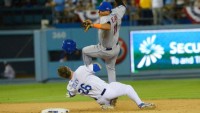
Next year, Chase Utley is going to be a utility player. He going to be a utility player because he’s 37 years old, and he has diminishing skills. He could retire, but he decided to hang around for another year or two. He’s not in this situation because someone injured him.
Last year, Ruben Tejada was not the starting shortstop on the Opening Day roster for the first time in his career. No, last year, the job was given to Wilmer Flores. Tejada was going to be a utility player to start the season. Then something strange happened. For all the years of the Mets just handing him the job, and him failing to hold onto it, Tejada finally rose to the challenge the year the job wasn’t just handed to him.
Last year, Flores had his offensive and defensive struggles. The Mets team was decimated by injuries. Tejada got some regular playing time. He then got some time at shortstop. He showed that while he had less range than Tejada, he had a steadier hand. More importantly, he began to hit:
- July .287/.330/.347
- August .235/.381/.294
- September .297/.357/.406
He entered the postseason as the Mets starting shortstop over Flores. He earned that right. Then with one dirty play Chase Utley took it all away. Tejada broke his leg. In the offseason, while he was hobbling around with a walking boot, the Mets signed Asdrubal Cabrera to take his place.
Utley reportedly reached out to David Wright to apologize to Tejada. He reportedly sent Tejada some things in the offseason. For his part, Tejada says all he wants is an apology.
Up until now, Utley has gone on and on about how he was playing hard and that he was playing the right way. However, his actions at least show remorse. The reason for this is he broke an unwritten rule, perhaps the most important rule amongst all players in all sports. You don’t injure other players with dirty, or even borderline plays. You don’t ruin another player’s career. Utley did that.
Utley took away Tejada’s job with one dirty play. Like Utley, Tejada is now a utility player. For what it’s worth, Tejada is not letting this hold him back:
I’m going to keep working hard, you never know what’s going to happen here. I want to stay focused all the time.
In 2015, Tejada was a utility player to start the season, and he finished the year as the starting shortstop. Utley put him back in that position this year. I’m not counting out Tejada this year, especially with dirty players like Utley out there.

While everyone is trying to decipher the outfield configuration after the Yoenis Cespedes signing, there is the issue of how the signing puts added importance on Wilmer Flores‘ ability to be a backup infielder.
Third Base
Make no mistake. The Mets need Flores to be able to handle the role and handle it well. For starters, we do not know David Wright‘s ability to withstand a full 162 game schedule. Last year, Wright had difficulty playing three days in a row. It impacted his offense and defense. With a full offseason to continue the extra work needed due to his spinal stenosis, that could change for Wright. It also may be a new reality.
Flores has to be ready, willing, and able to play third at a monent’s notice. In his major league career, Flores has only played 209 innings at third base. During that limited time, he did show the ability to handle the position. The problem is he has to work on his third base defense while addressing his second base defense.
Second Base
When the Mets acquired Neil Walker to replace Daniel Murphy, the Mets obtained a switch-hitting second baseman who has hit .272/.338/.427 over the course of his career. That’s with him coming off the worst year of his career last year when he hit .269/.328/.427 with 16 homers and 71 RBI. One of Walker’s issues last year was left-handed pitching. Walker hit a dreadful .237/.284/.290 in 62 games against lefties. For his career, Walker has hit an underwhelming .260/.317/.338 against lefties in his career. Effectively, Walker is a platoon player.
Ideally, that platoon parter would be Flores. However, Flores has to be able to hit lefties himself. Last year, Flores did that with aplomb. In 57 games, Flores hit .310/.355/.600 with 7 of his 16 homers against lefties last year. However, for his career, Flores has only hit .230/.288/.403 against lefties in his brief major league career. Overall, for the Walker trade to work Flores needs to be the 2015 version of himself against lefties as opposed to what he’s done against them in his entire career.
First Base
First base is where it starts to get dicey for Flores. With the Cespedes signing, Lucas Duda became the only player on the roster with any major league experience at first base. This forces Flores to learn a new position in addition to keeping prepared for his other backup roles.
How much Flores is needed will depend on Duda. Last year, Duda hit a respectable .285/.333/.545 with seven homers and 21 RBI in 82 games. However, much of that was fueled by an extraordinarily high BABIP of .385. For his career, Duda has hit .229/.301/.369 with a .321 BABIP. In short, Duda is due for a regression against lefties. It will be Flores’ job to cushion the fall back to earth while hoping his numbers against lefties doesn’t regress either.
Shortstop
The Mets signed Asdrubal Cabrera to be the new everyday shortstop. A role that used to belong to Flores. Cabrera’s backup to open the season should be Ruben Tejada, who actually wrestled the shortstop job away from Flores last year.
Here’s the issue. The one spot Flores isn’t backing up is the one spot he’s most needed. Last year, Cabrera had a -6.0 UZR and a -7 DRS at shortstop. For his career, he has a -55.5 UZR and a -29 DRS at short. Tejada had a -5.6 UZR and a -15 DRS at short last year. For his career, he has a -1.5 UZR and a -20 DRS there. Flores had a -2.5 UZR and a -10 DRS at short last year with a 1.5 UZR and a -13 DRS for his career.
So defensively, Flores is the best shortstop option. However, the Mets are going with Cabrera in the hopes that his .328/.372/.544 second half will carry forward because otherwise the Mets signed a shortstop who has hit .249/.307/.405 in the three years since his last All Star appearance. Ironically, the position Flores is best suited to on this team is not a position he is tops on the depth chart going into next season.
Pinch Hitter
Since this is the National League, Flores will need to be ready to pinch hit for the pitcher or for a left handed when a LOOGY enters the game. In his career, Flores has only had 13 plate appearances where he hit .250/.308/.333. These are around his career numbers of .253/.287/.386. Accordingly, Flores can reasonably be expected to replicate his career batting line as a pinch hitter next year. Whether that’s good or not is a whole other matter.
Conclusion
Surprisingly, much of what the Mets want to do lies on Flores’ shoulders. He had to platoon at second. He had to hit against tough left-handles while playing first. He has to be available at a moment’s notice to play third. He’s available to play each and every one of these roles because the Mets are placing their top shortstop option, Flores, on the bench.
Flores is still only 24 years old. He works hard, and he will do everything he can do to improve and help the team. He’s going to need to be proficient in three to four infield positions because the Mets really need his help.
Editor’s Note: this article first appeared on metsmerized.com
